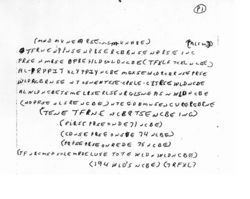A journalist contacted me this week to ask me about poor Ricky McCormick’s cryptic writing. I hadn’t written anything about this since 2013 and 2016, and even the Riverfront Times’ 2012 “Code Dead” article was now only in the Wayback Machine. An update was long overdue…
“Meet Me In St Louis, Louis…
…Meet me at the fair“. Do you know the song?
All the pieces of Ricky McCormick’s life were held together by the gravitational pull of downtown St Louis. It was where he grew up and went to school (sometimes), it was where he worked (sometimes) and travelled around on the buses, it was how he talked, it was where he lived (and indeed died). In my mind, the puzzle of Ricky McCormick’s notes (here and here) is likely to be not so much a code-breaking one as a geographical and linguistic one.
If we could only find a way to meet him in St Louis, we might stand a chance of reading (or at least reading through) his notes. To be brutally honest, I doubt that decrypting these will throw much light on his life (never mind his death), but his notes remain a puzzle, and one with its own gravitational pull.
Ricky McCormick’s notes
The distinctive series of letters “WLDNCBE” appears eight times in his notes: but so too does the same series with an apostrophe, i.e. “WLD’S NCBE“:
So it seems likely that this “WLD’S NCBE” is the full version of the phrase, and “WLDNCBE” is the quick version. Both WLD and NCBE also occurs lots of other times, with the latter often preceded by a number:
“PRSEON” is another common pattern, which I’ve long suspected could mean “person”:
Even just “SE” is something that appears a lot more frequently than you might normally expect:
McCormick also seems to use “XL” as a common pattern, so perhaps this was a phrase he liked? And there’s one word in there that looks a lot like a jumbled version of “special”:
There’s also something that looks like “MR DE LUSE”, though who that was remains unknown:
If not at the fair, then where?
Looking at Ricky McCormick’s notes, you can see plenty of short number groups (71, 74, 75, 194, 26, 35, 651, 74, 29, 99.84.52, 3, 1/2), plenty of letters, and plenty of word-like letter structure. It might therefore seem reasonable to conjecture that these might possibly be references to places in and around St Louis, all rendered in his own idiosyncratic (and very possibly dyslexic) style, and so effectively a private language only readable by him.
But… American street addresses don’t in general work like this at all (and certainly not in downtown St Louis). So if these are addresses, I think it’s highly likely that they’re for a specific neighbourhood with lots of adjacent-numbered flats. The most famous high-density living area in St Louis was the post-war Pruitt-Igoe high-rises: yet the last was demolished in 1976 (the site remains largely vacant). In fact, you may have seen footage of this without realising it, because some appeared in the (1982) film Koyaanisqatsi. So I’m kind of out of ideas here as to where these even might be.
All in all, I suspect it will take someone with a grasp of the sociogeography of downtown St Louis far better than me (along with a far better grasp of McCormick’s spoken accent) to come up with any candidate places. I’ve trawled Google Maps plenty of times and yet my net has always come up empty.
What do you think, Nick?
Pfffft… even in 2013 I wrote that “quite unlike other cipher mysteries, I don’t actually want to read what was written on McCormick’s two notes“: and I am, alas, still bobbing along in that same boat.
Still, it was nice to have an excuse to put up a blog post with a picture of Judy Garland, eh?










